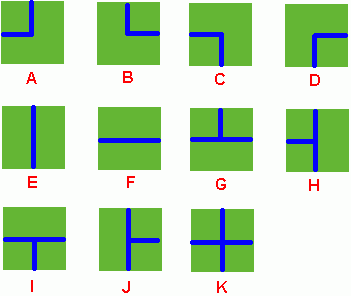hdu 1198 Farm Irrigation(并查集)
2016-01-13 19:23
369 查看
Problem Description
Benny has a spacious farm land to irrigate. The farm land is a rectangle, and is divided into a lot of samll squares. Water pipes are placed in these squares. Different square has a different type of pipe. There are 11 types of pipes, whichis marked from A to K, as Figure 1 shows.

Figure 1
Benny has a map of his farm, which is an array of marks denoting the distribution of water pipes over the whole farm. For example, if he has a map
ADC
FJK
IHE
then the water pipes are distributed like

Figure 2
Several wellsprings are found in the center of some squares, so water can flow along the pipes from one square to another. If water flow crosses one square, the whole farm land in this square is irrigated and will have a good harvest in autumn.
Now Benny wants to know at least how many wellsprings should be found to have the whole farm land irrigated. Can you help him?
Note: In the above example, at least 3 wellsprings are needed, as those red points in Figure 2 show.
Input
There are several test cases! In each test case, the first line contains 2 integers M and N, then M lines follow. In each of these lines, there are N characters, in the range of 'A' to 'K', denoting the type of water pipe over the correspondingsquare. A negative M or N denotes the end of input, else you can assume 1 <= M, N <= 50.
Output
For each test case, output in one line the least number of wellsprings needed.Sample Input
2 2 DK HF 3 3 ADC FJK IHE -1 -1
Sample Output
2 3
题意:判断输出连通分支数
#include <cstdio>
#include <cstdlib>
#include <climits>
#include <iostream>
#define MAX 55
using namespace std;
//0,1,2,3分别代表左,上,右,下
//用来存储每一种类型的管道,按照左上右下的顺序,0代表无管道输出,1代表有管道输出
int type[11][4]={{1,1,0,0},{0,1,1,0},
{1,0,0,1},{0,0,1,1},
{0,1,0,1},{1,0,1,0},
{1,1,1,0},{1,1,0,1},
{1,0,1,1},{0,1,1,1},
{1,1,1,1}
};
int father[MAX*MAX],m,n;
char farm[MAX][MAX];
//初始化函数
void init(int n){
for(int i=1;i<=n;++i){
father[i] = i;
}
}
//查找函数
int find_father(int x){
if(x!=father[x]){
father[x] = find_father(father[x]);
}
return father[x];
}
//计算连通分支数
int find_ans(int n)
{
int sum=0;
for(int i=1;i<=n;i++)
{
if(father[i]==i)
sum++;
}
return sum;
}
//引入a管道和b管道的坐标
void solve(int ax,int ay,int bx,int by,bool dir){ //a管道在b管道前面,故只需要判断b是否越界
if(bx>n || by>m)return;
bool mark = false;
int ta,tb;
ta = farm[ax][ay]-'A';
tb = farm[bx][by]-'A';
if(dir){
if(type[ta][3] && type[tb][1])mark = true; //竖直方向联通 }
else{ if(type[ta][2] && type[tb][0])mark = true; //水平方向联通 }
//普通并查集的合并函数
if(mark){
int fx = find_father((ax-1)*m+ay);
int fy = find_father((bx-1)*m+by);
if(fx>fy){ father[fy] = fx; }
else father[fx]=fy;
}
}
int main(){
int i,j;
while(scanf("%d %d",&n,&m)!=EOF)
{
if(n==-1 && m==-1)break;
init(n*m);
for(i=1;i<=n;++i)
{
cin>>(farm[i]+1);
}
for(i=1;i<=n;++i)
{
for(j=1;j<=m;++j)
{
solve(i,j,i+1,j,true);
solve(i,j,i,j+1,false);
}
}
int ans=find_ans(n*m);
printf("%d\n",ans);
}
return 0;
}
相关文章推荐
- Magic Spheres
- iOS 4种传值总结
- Oracle中的触发器
- Exception:org.eclipse.epp.internal.logging.aeri.ui.log.StandInStacktraceProvider$StandInException
- SQL Server 2008更新操作基本格式
- JAVA WEB filter
- Qt使用插件的形式调用DLL
- 开启前端探究之路
- 中国历年存款、贷款利率(1990-2015)Echarts图表设计
- Java 直连Hive Server运行Hive SQL
- 蓝桥 分糖果 (模拟)
- 点餐系统(五)——获取附近餐馆
- 一步步学习Linux开发环境搭建与使用
- 无法导入以下密钥文件
- hdoj1994利息计算
- 实现带描边的圆角图片
- C#-MVC开发微信应用(7)--在管理系统中同步微信用户分组信息
- web应用发布到tomcat图片无法显示的问题
- linux服务器开启core开关,设置core文件路径
- python学习之2 正则表达式re
